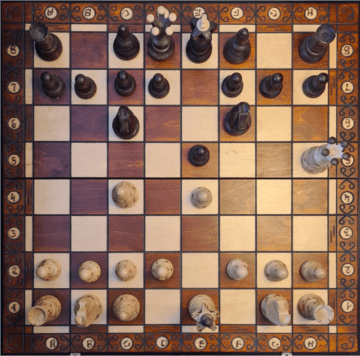by Jochen Szangolies

Even if you’ve never played chess in your life, the image in Fig. 1 is probably readily identifiable to you. The regular grid of the chessboard, white and black standing in opposition, perhaps even the individual pieces—knights, pawns, bishops, and so on—are a cultural staple.
If you have some familiarity with the rules of chess, however, you will see more than that: rather than a mere configuration of items, you’ll see moves—options, dangers, strategies. For instance, the white queen is threatened by the knight on f6: a knight always moves in a specific way, one step diagonally, one step straight, allowing it to move to the white queen’s spot to capture. To evade, the white queen could capture the black pawn on e5—but then, would be captured by the knight on c6. A much better option—the move this particular configuration of pieces seems to scream out to you, if you’re a chess player with some experience—is for the white queen to move to f7, capturing the pawn, for check and mate: the so-called ‘Scholar’s Mate’.
Familiarity with the rules of chess adds a semantic dimension to the chessboard. The pieces acquire a particular, individual character: the knight is that particular piece that moves one straight and one diagonal; the bishop is the piece that moves diagonally; and so on. Rules transform the chess pieces from inert physical objects to something with a particular identity, something almost agent-like, capable of acting towards a certain goal. However, removed from the chessboard, they loose this character: a bishop and a rook, connected at their bases, make for a passable model rocket ship, for example.
Indeed, in a pinch, you could easily take a chess pawn to replace one of the tokens in a game of Ludo, or Halma—there, despite its somewhat odd looks, it will nevertheless fit right in, given a new identity by a new set of rules.
The chess-, Ludo-, and Halma-boards are examples of rule spaces. Read more »
